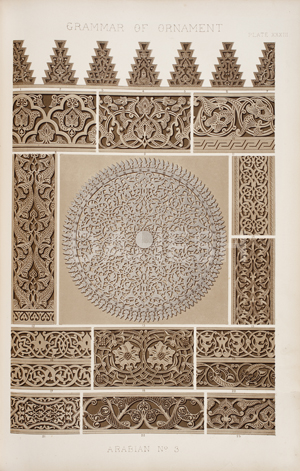Owen Jones (British, 1809–1874)
From The Grammar of Ornament. London: Day and Son, 1856
Arabian No. 3, pl. 33
Color lithograph, 22 x 14 3/4 in.
2010.1

Jones was captivated by Arab or medieval Islamic architecture and the ornamentation of Egypt. He especially praised Cairo mosques as “amongst the most beautiful buildings in the world,” for the “grandeur and simplicity of their forms” and their “refined and elegant decoration.”
Jones included examples from Cairo of this exquisite vegetal pattern ornament—often referred to as “arabesque”—to illustrate forms of nature, which he believed inspired the best design ideas. He states in Proposition 11: “In surface decoration all lines should flow out of a parent stem,” and cites the concept as an Oriental practice.
All the drawings for the “Arabian” plates were provided by Jones’s brother-in-law, the architect James Wild, who studied Islamic architecture and decoration in Egypt and Syria.


